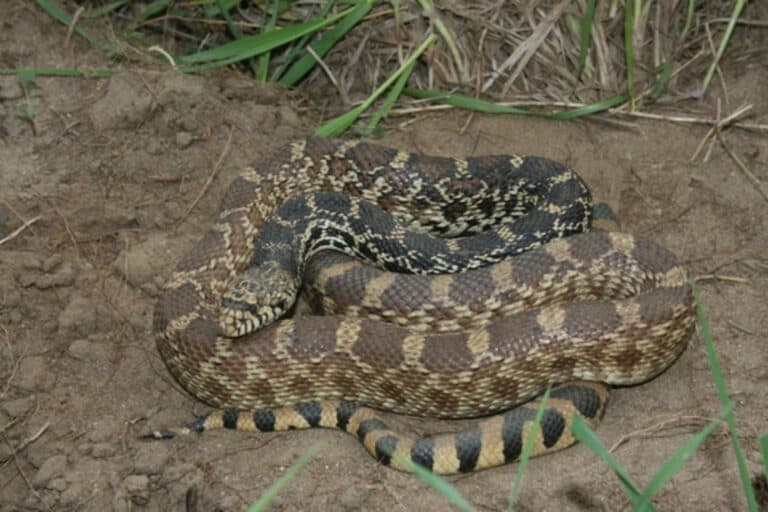
There are countless species of snake the spread across North America and the rest of the globe, and though most of these snakes are harmless or nearly so, some snakes possess a deadly, poisonous bite.
Learning to identify poisonous snakes can help put your mind at ease and also prevent unfortunate run-ins with the more dangerous variety.
How about the bullsnake that is so common through the Midwest and on the west coast? Are bullsnakes poisonous?
No, bullsnakes are not poisonous at all, though many varieties closely resemble the deadly poisonous rattlesnake (they even hiss and rattle their tails just like one).
Bullsnakes are big, long and powerfully muscle snakes, and their typical coloration can lead to them being easily confused with their deadly cousins.
That being said, if you know you are dealing with a bullsnake you have nothing to fear. Keep reading to learn more about these impressive specimens.
What Do Bullsnakes Look Like?
The most distinctive characteristic of the bullsnake is its immense size, with adults ranging anywhere from 3 ft to upwards of 6 ft, and all are thick heavy bodied snakes.
The base coloration is usually somewhere between off-white or cream and an ocher yellow or tan color, and there are regularly spaced but slightly irregularly shaped Brown to brown black blotches all along its back and flanks.
These are markings are usually described as saddle-shaped, and are what typically results in the bullsnake being misidentified as a rattlesnake.
The belly of the snake is similarly colored, most often appearing ivory or pale yellow with a checkerboard pattern of black or dark brown spots that are square or nearly so along the park closest to the flanks.
Looking closer, the end of the tale may have an alternating pattern of dark and lightly colored bands, while the broad, thick head sometimes features a dark “eyeliner” that stretches between the bottom of the eye and the jaw. The mouth may feature black or dark brown bars alongside the upper jaw.
Most notably, and this will be important later, bullsnakes do not have a rattle on the end of their tail. More on that in just a minute.
Are Bullsnakes Venomous?
No, bullsnakes are alongside the non-venomous snakes‘ category. Bullsnakes are very muscular, and accordingly quite powerful constrictors.
It is through constriction, not venom, that they dispatch prey they cannot simply swallow whole.
Where are Bullsnakes Found?
Bullsnakes are a subspecies of gopher snake, and accordingly are found sporadically to commonly in the Midwest and commonly in the southwest and along the west coast.
Usually considered a prairie species of snake, they can be found commonly in fields, near rivers, in pastures and increasingly in areas with sparse trees. Despite their size, these snakes are adept and fast climbers.
Unlike some other snakes, bullsnakes are typically active in the daytime during the warmer months, either basking in the sun to increase their body temperature or hunting for food.
They retire at night, typically sheltering under thick vegetation, beneath rocks or any other object they can squeeze under.
Bullsnakes are capable of digging their own burrow, using the enlarged, hardened scales near their nose to assist with this task.
They also commonly make use of the burrows of other animals, particularly mammals, for the purpose.
How Likely are Bullsnakes to Bite?
Bullsnakes are actually fairly likely to bite when approached or threatened. Because of their size, bullsnakes are constantly on the hunt for prey, and a large adult snake can eat several smaller prey items in a matter of minutes.
Accordingly, whenever they detect a larger animal approaching them, an animal that is too big to eat, they assume automatically that it is a threat to them and act accordingly.
A typical bullsnake defense consists of freezing in place before darting for cover or else rearing up in the classic s-shaped pre-strike posture, hissing loudly, and rattling their tail against the ground or nearby vegetation in order to simulate the warning buzz of its deadly cousin, the rattlesnake.
Although they would greatly prefer retreat to combat, they will strike if approached at this time and they can strike from quite a distance.
Does Their Bite Hurt?
Yes, you better believe it will hurt! Despite lacking fangs and venom, bullsnakes are very large and powerful creatures nonetheless, and they have a correspondingly large head and teeth.
A bite from a bullsnake can easily lacerate skin and result in a nasty wound, and they may strike repeatedly.
Although such an injury is not likely to be life-threatening in and of itself by any means, a subsequent infection might be.
Make it a point to thoroughly clean and disinfect any bite from a bullsnake, and seek medical attention just to be on the safe side because you’ll probably need a course of antibiotics.
Are Bullsnakes Aggressive Toward People?
No, not really. You could be forgiven for thinking otherwise based on everything you’ve read so far, but bullsnakes are not truly aggressive toward people.
Instead, think of them as being very quick to go on the defense, but the purpose of their defense is to ensure that they can escape. They don’t want to hurt you!
Generally, if you come upon a bullsnake you should expect it to immediately go into that s-shaped defensive posture, complete with a ferocious hissing and the startling buzz of their tail being beaten against the ground or nearby vegetation.
This is immediate calls for alarm, of course, but if you keep your wits about you and back away from the snake there shouldn’t be any problem whatsoever and it will bolt as soon as it feels certain about his chances.
If you’re trying to positively identify the bullsnake and make sure it is not a rattlesnake, look closely at the tail when it is still or when it is buzzing.
Bullsnakes do not have a rattle on their tail, at all, and furthermore when they are beating their tail they tend to keep it close to or right against the ground. Rattlesnakes will elevate their tail when buzzing, typically.
In any case, just give the snakes some room and it will soon depart.
Will Bullsnakes Bother Animals?
They definitely can. As mentioned above, these are big, powerful snakes and they have big appetites which means they need to hunt regularly.
A bullsnake will rapidly devour bird eggs or chicks in succession, and they are common predators of all sorts of rodents.
You’ll definitely need to be on your guard if you have a small puppy or kitten, and it is far from out of the question that a bullsnake could simply kill a smaller dog by constricting it.
Even against larger animals, you couldn’t rule out that the appearance of a bullsnake could panic sheep, goats, cows and horses.
Though the snake has no chance of hurting these animals, the subsequent stampede or frenzied attempt to get away from the snake could result in injuries.
Should You Kill Bullsnakes?
No! As intimidating as they look, bullsnakes are extremely important ecologically.
Although they may prove to be a menace to keepers of chickens and other poultry, these snakes are important predators of all kinds of crop pests. In fact, they are the primary predator of mice, rats and voles in certain areas.
If you are keeping chickens, ducks, rabbits or other smaller animals and a bullsnake is helping himself to your flock or herd, try to get the snake relocated instead of killing it.
If you have a large garden or grow crops, and you know you have bullsnakes hanging around, give thanks, because he’s going to get rid of the animals that will tear up your crops in a hurry.
Tom Marlowe practically grew up with a gun in his hand, and has held all kinds of jobs in the gun industry: range safety, sales, instruction and consulting, Tom has the experience to help civilian shooters figure out what will work best for them.


